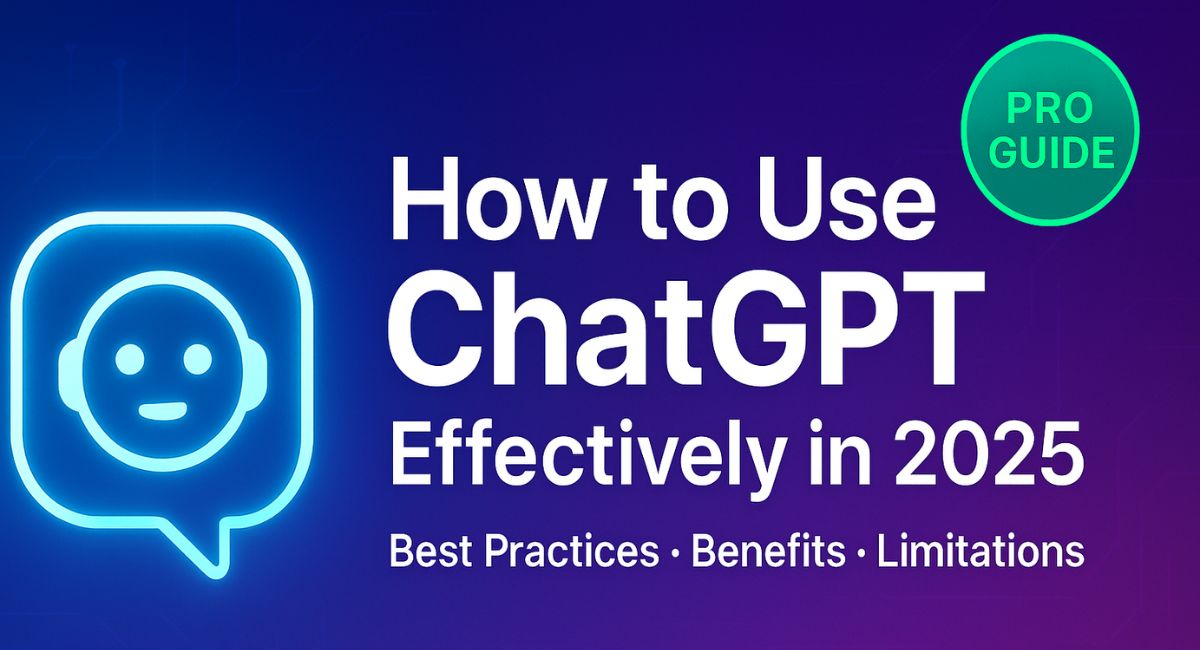How to Use ChatGPT Effectively: Best Practices, Benefits & Limitations
Introduction: Why ChatGPT Usage Matters in 2025
ChatGPT usage is transforming how businesses, creators, and professionals work in 2025. From content creation and SEO optimization to customer support and coding assistance, ChatGPT has become a go-to productivity tool. But to achieve maximum output, you need to know the best practices for ChatGPT—not just how to ask questions, but how to design effective prompts, refine responses, and combine AI with human expertise.
This guide explores the practical applications, benefits, limitations, and strategies for using ChatGPT effectively in business, marketing, education, and beyond.
Practical Applications of ChatGPT for Productivity & Business
1. ChatGPT for Content Creation and SEO
- Generate blog posts, product descriptions, and email marketing campaigns.
- Craft keyword-rich articles that rank on Google and appear in AI-driven answer engines.
- Create engaging social media captions and ad copy.
Best Practice Tip: Use prompts like “Write a 1500-word SEO article on AI trends with headings, FAQs, and a conversational tone.”
2. ChatGPT in Customer Support
- Build ChatGPT-powered chatbots to automate FAQs.
- Offer 24/7 multilingual support.
- Reduce response times while improving customer satisfaction.
3. ChatGPT for Coding Assistance
- Debugging code, writing functions, and automating tasks.
- Explaining complex programming concepts in simple terms.
- Generating clean, reusable code snippets.
4. ChatGPT in Business Productivity
- Summarize reports, proposals, and contracts.
- Assist in brainstorming, research, and decision-making.
- Streamline internal communications with quick drafts.
5. ChatGPT in Education & Research
- Create study guides, quizzes, and lesson plans.
- Simplify advanced theories for students.
- Offer AI-powered tutoring with step-by-step explanations.
Benefits of ChatGPT Usage in 2025
- Time Efficiency: Handles repetitive tasks instantly.
- Scalability: Manages multiple queries at once.
- Versatility: Useful across industries from e-commerce to healthcare.
- Creativity Boost: Provides fresh perspectives and content ideas.
- SEO Advantage: Helps optimize content for both search engines and answer engines (AEO).
Limitations of ChatGPT: What to Watch Out For
Despite its benefits, ChatGPT has limitations:
- Accuracy Issues: May generate outdated or incorrect data.
- Over-Reliance Risk: Can replace human creativity if used passively.
- Context Boundaries: Struggles with nuanced or ambiguous prompts.
- Privacy Concerns: Avoid sharing sensitive or confidential data.
👉 Best Practice: Always fact-check and humanize AI outputs before publishing.
Best Practices for Using ChatGPT for Maximum Results
- Craft Clear, Context-Rich Prompts
- Example: “Write a LinkedIn post in a motivational tone for startup founders about AI adoption in 2025.”
- Use Iterative Refinement
- Ask follow-up questions.
- Request rephrasing: “Make it shorter and add bullet points.”
- Leverage ChatGPT for SEO & AEO
- Generate keyword-rich content.
- Request schema markup, meta descriptions, and FAQ answers.
- Balance AI with Human Expertise
- Add personal insights, case studies, and expert commentary.
- Improves Google EEAT compliance and builds trust.
- Stay Updated
- Verify outputs with the latest sources.
- Update AI-generated articles regularly for freshness.
Real-World Use Cases of ChatGPT
- Marketing Agency: Creates campaign copy and tests ad variations.
- E-Commerce Brand: Uses ChatGPT chatbots to handle customer queries.
- Software Developers: Automate boilerplate code and explanations.
- Educators: Develop personalized learning materials.
Expert Insights: How to Use ChatGPT Effectively
- Co-pilot, not replacement: ChatGPT enhances productivity but shouldn’t replace strategic human thinking.
- Great for ideation, not final decisions: Always combine AI suggestions with expertise.
- Pair with tools: Use alongside SEO platforms, analytics tools, and fact-checking systems.
FAQs on ChatGPT Usage in 2025 (SEO + AEO Optimized)
Q1: What is the best way to use ChatGPT for SEO content?
The best way is to give structured prompts with target keywords, headings, meta descriptions, and FAQs. This ensures your article ranks in Google and AI-powered answer engines.
Q2: Can ChatGPT replace human writers?
No. While ChatGPT speeds up content creation, human expertise and storytelling remain essential for EEAT compliance and audience trust.
Q3: How do I get more accurate answers from ChatGPT?
Use context-rich prompts, fact-check responses, and refine outputs iteratively for maximum accuracy.
Q4: Is ChatGPT safe for business use?
Yes—when used responsibly. Avoid inputting sensitive data and always review AI outputs before publishing or deploying.
Q5: What are the limitations of ChatGPT in 2025?
Accuracy gaps, lack of contextual depth, and privacy risks are the main limitations of ChatGPT. Always combine AI insights with human review.
Conclusion: Unlocking the Full Potential of ChatGPT Usage
The best practices for ChatGPT revolve around clear prompts, refinement, fact-checking, and human oversight. Whether you’re using ChatGPT for SEO, customer support, business productivity, or education, success depends on strategic usage.
👉 To maximize results: be specific, iterate, fact-check, and add a human touch.
By combining SEO optimization, AEO strategies, and EEAT principles, you can make ChatGPT a powerful co-pilot for your business and personal growth in 2025.



